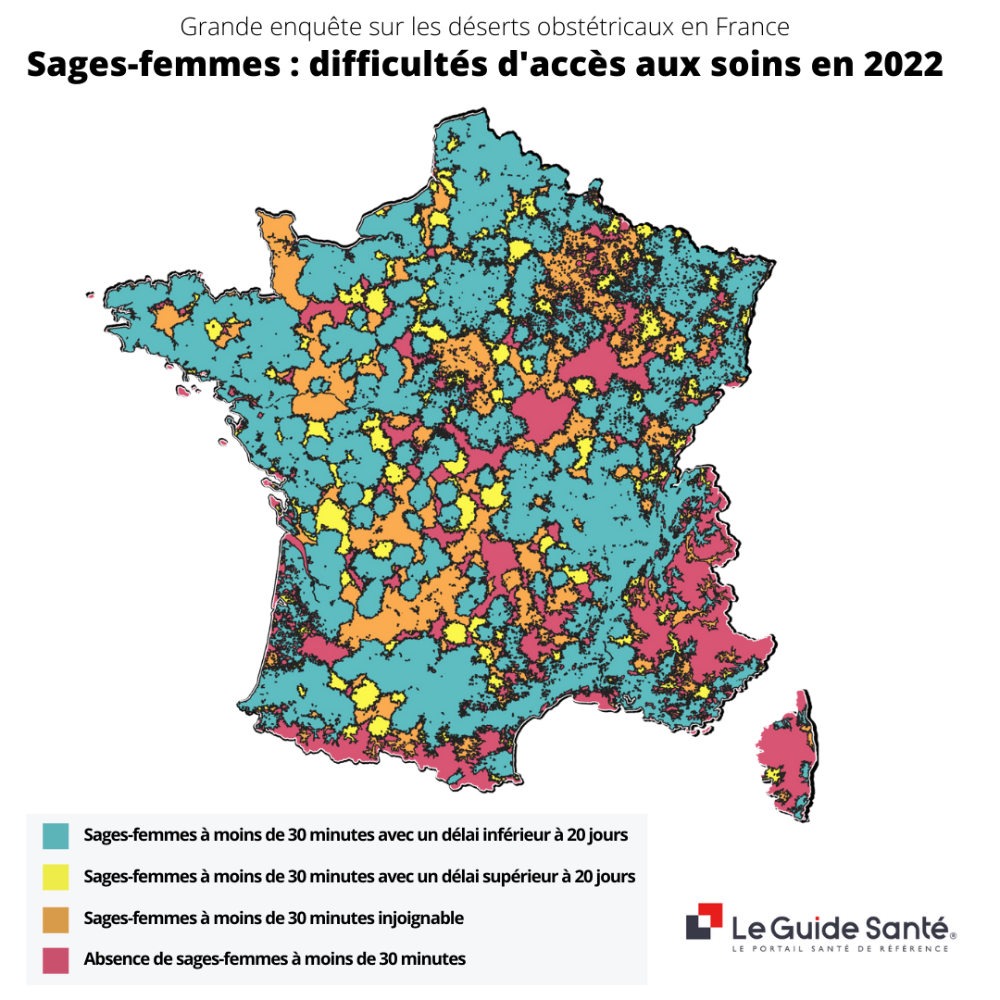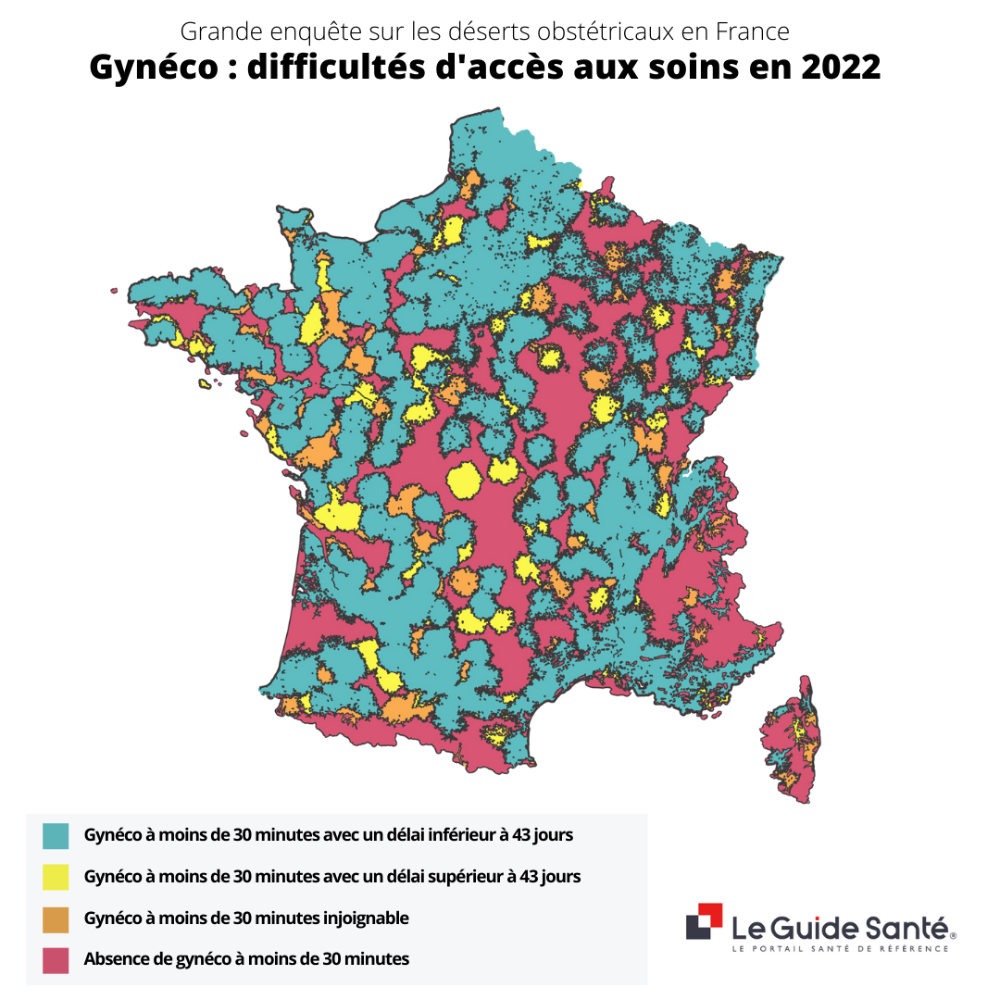Posted ,
Reading 4 mins.
The Le Guide Santé group is today publishing on its website a study on obstetric deserts in metropolitan France. Is France faced with a lack of practitioners? What can be done to improve the situation? The answers of Dr Stéphane Bach, public health doctor and director of the Health Guide.
Is there inequality in access to obstetric care in France? In any case, this is the finding drawn by the Health Guide in a study published on April 5 on their site. To arrive at their results, the Guide Santé team conducted a study that combines the waiting time for an appointment with a specialist (gynecologist or midwife), the distance to get to this appointment ( more or less than 30 minutes by car) and classified their results according to four levels of difficulty.
Three indicators and four difficulty levels
The chosen indicators are therefore:
- A car delay of less than 30 minutes to reach a maternity hospital;
- A car delay of less than 30 minutes to reach a gynecologist, whose average appointment time is less than or equal to the national average which is 43 days;
- A car delay of less than 30 minutes to access a midwife, whose average appointment time is less than or equal to the national average, which is 20 days.
“The thirty-minute period was chosen because it is considered the maximum acceptable time for emergencies, beyond that it is too much” says Dr. Stéphane Bach, head of the study, public health doctor and director of the Health Guide.
And the four levels of classification to determine access to care are:
- Without difficulty in accessing care;
- A level of difficulty of access to care (therefore one of the three indicators present)
- Two levels of difficulty of access to care (therefore two out of three indicators present)
- Three levels of difficulty of access to care (all indicators present)
Follow your pregnancy week by week
Up to three phone calls made
The Health Guide team therefore opted for the so-called “mystery shopper” method, calling up to three midwives and gynecologists, to get an appointment. Objective: cross-reference these results with a map of France, using software, in order to list the results town by town and obtain maps of France indicating the difficulty of access to obstetric care.
Inequality in obstetric care
According to their results, there is indeed an inequality of access to obstetric care in France, which “concerns the same regions as that of the medical deserts” says Dr Stéphane Bach.
As proof, on the “5,907 gynecologists contacted, only 3,795 appointments were obtained, and 2,112 remained unreachable after 3 calls” says Dr. Bach. Ditto for midwives:7,227 midwives were contacted, for which 3,916 appointments were obtained, and almost half – 3,311 midwives – remained unreachable after 3 calls” says Dr. Bach again.
More than six million people more than 30 minutes from a maternity hospital
The results of the survey also show that, in addition to the difficulty of finding an available practitioner, 6,784,973, or just over 10% of the French population, inhabitants of 11,826 municipalities in France, are more than 30 minutes away of a maternity ward.
What do the women who live in these places do? “They have no choice but to extend their journeys, instead of driving half an hour, they will do one or more” complains the doctor.
“Obstetric deserts” in certain regions of France
For the other results of this survey, we find:
- 1,316,842 people, in 3,919 municipalities, with 3 levels of difficulty of access to obstetric care;
- 4,997,810 people, in 8,315 municipalities, live in areas with 2 levels of difficulty of access to obstetric care;
- 9,438,766 people, in 9,167 municipalities, live in areas with 1 level of difficulty in accessing obstetric care;
- 49,088,206 people in 13,467 municipalities live in an area with no difficulty in accessing obstetric care.
For the authors of this study, people with 3 levels of difficulty in accessing obstetric care are in “an obstetric desert”who is “an area in which access to maternity care services is limited or non-existent, either due to lack of services or barriers to a woman’s ability to access such care”.
More than 15 million people have at least one level of difficulty accessing care
“This shows us that there are more than 15 million people – 15,753,418 people exactly – who find themselves with at least 1 difficulty in accessing healthcare, i.e. nearly a quarter of the population in France. says Dr. Bach again, “with astonishing disparities: in Corsica for example, more than 76% of the population has at least one difficulty in accessing healthcare, and conversely only 1.7% of the population in Île-de-France”.
The doctor also points out that in a medium-sized city like Laval, which has 50,000 inhabitants and is located in Mayenne, in the Pays de la Loire region, “it was impossible to reach a midwife and a gynecologist by phone”.
A recourse to foreign doctors
The conclusions of this study raise the question of the solutions envisaged for the years to come. “We talk about homes or birth centers as alternatives, there are currently only seven in France, while it would take a hundred to see a real effect.“adds Dr. Bach.”And training staff is essential, what will be the use of these birth centers if the staff is lacking? he hammers again.

For him, there is no miracle recipe. “Telemedicine is not an answer to consider in this situation. Personally, I believe that the number of midwives in training must be significantly increased. On the other hand, for gynecologists-obstetricians, whose studies are longer, we have no other choice than to call on doctors from abroad to fill the gap. he concludes.

